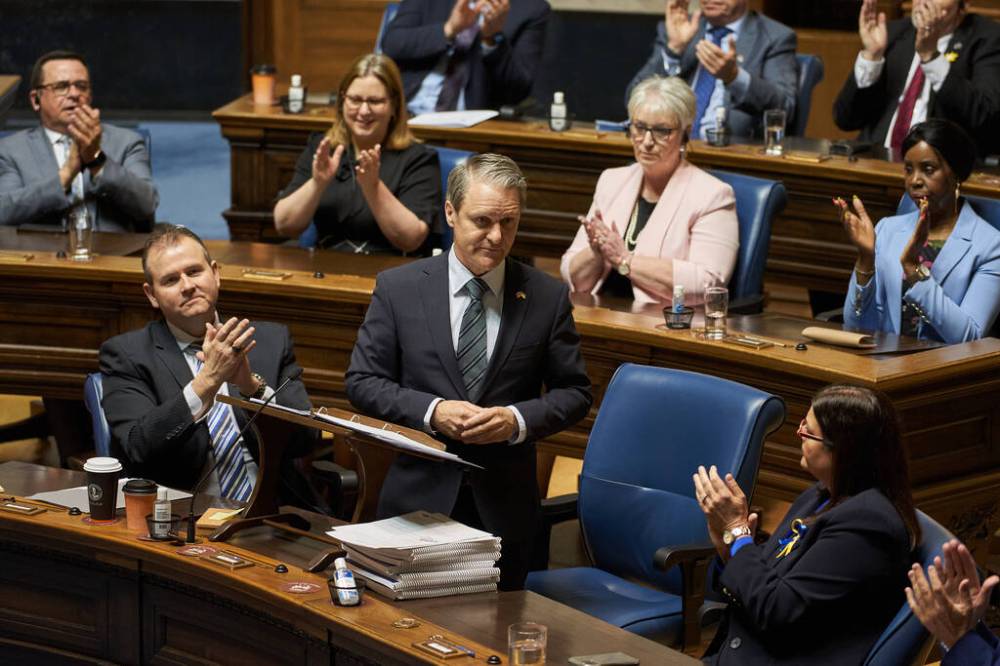Provincial budget fails to chart new course
Read this article for free:
or
Already have an account? Log in here »
To continue reading, please subscribe:
Monthly Digital Subscription
$0 for the first 4 weeks*
- Enjoy unlimited reading on winnipegfreepress.com
- Read the E-Edition, our digital replica newspaper
- Access News Break, our award-winning app
- Play interactive puzzles
*No charge for 4 weeks then price increases to the regular rate of $19.00 plus GST every four weeks. Offer available to new and qualified returning subscribers only. Cancel any time.
Monthly Digital Subscription
$4.75/week*
- Enjoy unlimited reading on winnipegfreepress.com
- Read the E-Edition, our digital replica newspaper
- Access News Break, our award-winning app
- Play interactive puzzles
*Billed as $19 plus GST every four weeks. Cancel any time.
To continue reading, please subscribe:
Add Free Press access to your Brandon Sun subscription for only an additional
$1 for the first 4 weeks*
*Your next subscription payment will increase by $1.00 and you will be charged $16.99 plus GST for four weeks. After four weeks, your payment will increase to $23.99 plus GST every four weeks.
Read unlimited articles for free today:
or
Already have an account? Log in here »
Hey there, time traveller!
This article was published 13/04/2022 (1335 days ago), so information in it may no longer be current.
If the 2022 Manitoba budget was intended to provide a lifeline for the Progressive Conservative government, it must surely be considered a failure.
Prior to the budget’s release, Premier Heather Stefanson and her government were teetering on the edge of the political abyss. Manitobans are profoundly unhappy with the government’s performance on most issues, including pandemic management. National polls show Ms. Stefanson is Canada’s least popular premier.
National polls show Ms. Stefanson is Canada’s least popular premier.
That political context made this budget a high-priority project for the Tories. It was, simply put, their best chance to shed the lingering burden left by former premier Brian Pallister, and rebuild the party brand under a new leader.
Unfortunately, Ms. Stefanson’s first budget remains shackled to the deeply flawed fiscal and political logic that defined the Pallister years. And no single budgetary measure embodies that failure more than the premier’s decision to continue cutting education property taxes.
.jpg?w=1000)
Property owners received a 25 per cent rebate on the education levy last year; that increases to 37.5 per cent this year, and 50 per cent next year. Added to the broad array of other tax cuts unleashed over the past six years — the PST cut, retail sales tax exemptions and the indexing of the basic personal income tax exemption — the PC government will have spent more than $1.2 billion on tax cuts while strangling core services with a noose of austerity.
When he was first elected in 2016, Mr. Pallister promised a balanced approach to managing the budget. The PC government would “fix” such things as health care and education, while also slowing the rate of spending increases. The result would be better services, a balanced budget and — longer term — lower taxes.
Six years later, it’s clear that “balanced” approach was political smoke and mirrors.
When he was first elected in 2016, Mr. Pallister promised a balanced approach to managing the budget.
Contrary to what he promised, Mr. Pallister did not wait until services were restored and the budget was balanced before cutting taxes. Even the pandemic, with its extraordinary unfunded liabilities, did not dull Mr. Pallister’s appetite for tax relief; he introduced the first property-tax rebate in the spring of 2021, while the province was deep in the COVID-19 pandemic and accumulating the province’s highest-ever budget deficit.
Ms. Stefanson’s budget maintains Mr. Pallister’s single-minded devotion to tax cuts, a clear sign she does not want to break from her predecessor’s legacy.

Just as Mr. Pallister did throughout his time in office, Ms. Stefanson and Finance Minister Cameron Friesen continue to give away valuable own-source revenues while starving core services of funding. Overall health-care funding is increasing by only 1.6 per cent in this year’s budget, well below the rate of inflation.
Even when you add a one-time investment of $110 million to address surgical and diagnostic procedure backlogs — money pledged to initiatives that have yet to be defined — the Stefanson government is spending five dollars on tax cuts for every one additional dollar it is investing in restoring health care.
To borrow a phrase from the province’s pandemic response, “now is not the time” for massive tax cuts. Manitoba is still struggling to escape historic levels of deficit and debt. Core services, led by health care and public education, are in tatters. The pandemic continues to create fiscal uncertainty. Oh, and there’s now an increased likelihood of a spring flood.
Manitoba is still struggling to escape historic levels of deficit and debt. Core services, led by health care and public education, are in tatters.
Ms. Stefanson had an opportunity to show members of her own party, and the broader Manitoba electorate, that she is a different kind of Progressive Conservative— one with a better grasp of what “balanced approach” really means.
Instead, she has chosen to follow the course charted by her predecessor, even though it’s a path that leads to almost-certain electoral disaster.















.jpg?h=215)